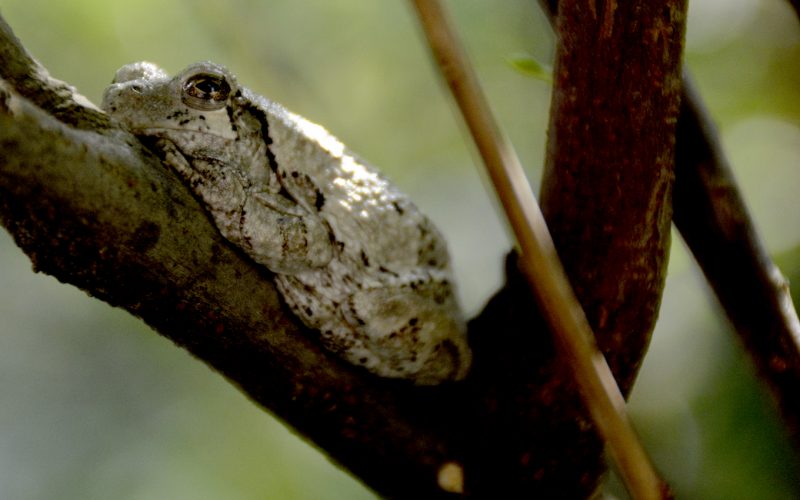
Staff Photo Amanda Bancroft
Gray Treefrogs like this one found near Fayetteville are able to change their color slightly to blend in with their surroundings. They are typically shades of gray or mossy green.
Many Harry Potter fans are getting excited about J. K. Rowling’s Fantastic Beasts and Where to Find Them coming to theaters this November. Even though Northwest Arkansas lacks dragons and mythical creatures, we are home to some fantastic frogs that will amaze and delight people of all ages. Bonus: they won’t actually give us warts, and they’re far safer than the beasts of fantasy. But always wash your hands both before and after catching one, since toads have poison glands behind their eyes, and our hands contain bacteria that could make them sick.
Frogs are amphibians, meaning they have dual lives: one on land, and one in the water. Most begin life inside an egg laid in water, have gills to breathe underwater as tadpoles, and emerge to breathe air through their nostrils once becoming froglets on land. They don’t drink water like humans do; instead, they absorb water through their skin whether it’s from morning dew on the grass, soil when they’re burrowed underground, or from a pond or other body of water. This makes them particularly sensitive to water pollution. For various reasons, 200 amphibian species have already gone extinct since 1979, according to Save the Frogs.
Worldwide, frogs are pretty diverse, and our own local 29 species of frogs and toads can be vastly different from one another. For example, toads lay their eggs in necklace-like strings, while frogs lay clumps of hundreds of eggs. Spring peepers and Dwarf American Toads are very tiny and hard to spot, while the American Bullfrog is huge comparatively. Males are typically the ones who call and compete for mates, and each species may have specially tuned hearing to register the frequency of their own species’ call to distinguish it from the cacophony in a pond at night. You can learn to identify frog calls at ArkansasFrogsandToads.org
Our resident frogs are beautiful and entertaining, flailing around a puddle as tadpoles and often hiding gold in their eyes or bright yellow or green in various folds of skin. You may not have to go far to find one; I’ve spotted large and small frogs and toads outside of urban apartments and backyard gardens, front yards in wet grass, in a toilet, and even a mailbox! Though they are camouflaged, here are some tips to find these fantastic frogs:
1. If it’s raining and safe, go outside and listen! Follow the sound of their calls.
2. At night, grab a flashlight and look for their eyes to reflect the light back.
3. Search for frogs in nearby ponds, roadside ditches, or even large puddles in a park or backyard.
4. Visit a local marsh or wetland to see many frogs and other species at once.
5. Don’t overlook bushes, decaying logs, and trees: frogs can often be found clinging to branches.
Amanda Bancroft is a writer, artist, and naturalist building an off-grid cottage for land conservation on Mt. Kessler. She and her husband Ryan blog about their adventures and offer a solar-hosted online educational center on how to make a difference with everyday choices at: www.RipplesBlog.org.










